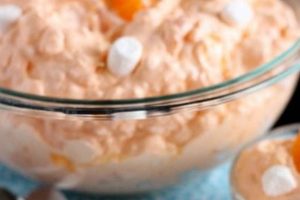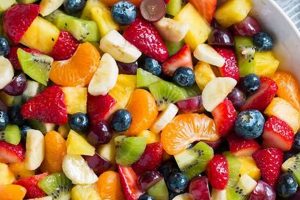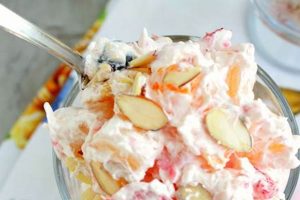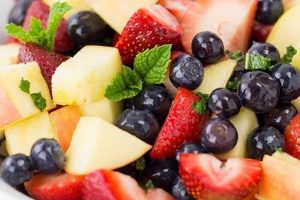A blend of various fruits, typically fresh and sometimes canned, combined with a mayonnaise-based dressing creates a unique culinary experience. This combination often includes apples, grapes, and pineapple, with the creamy dressing adding a contrasting texture and flavor. Variations can incorporate different fruits and seasonings within the dressing to create a sweet and savory profile.
This type of salad, popular in certain regions and cultures, offers a distinct textural and flavor contrast. The mayonnaise provides a richness and creaminess that complements the sweetness and acidity of the fruits. Historically, such combinations may have arisen from a need to preserve or enhance the flavors of available produce. The dressing can also serve as a binding agent, holding the diverse ingredients together. This preparation can be a refreshing side dish or a unique dessert option.
Further exploration will delve into specific ingredient combinations, regional variations, nutritional information, and preparation methods for this distinctive salad. Detailed recipes and serving suggestions will also be provided.
Tips for Creating a Delicious Fruit Salad with a Mayonnaise-Based Dressing
Achieving a balanced and flavorful fruit salad with a mayonnaise dressing requires careful consideration of ingredient selection, preparation techniques, and flavor pairings. The following tips offer guidance for creating a successful dish.
Tip 1: Fruit Selection: Opt for a variety of fruits with complementary flavors and textures. Consider incorporating both sweet and tart fruits, such as apples, grapes, pineapple, and oranges. Avoid overripe or bruised fruits.
Tip 2: Dressing Preparation: Use high-quality mayonnaise as a base. Enhance the flavor profile by adding complementary ingredients such as whipped cream, yogurt, or sour cream. Sweeteners like honey or maple syrup can balance the tartness of certain fruits.
Tip 3: Flavor Balancing: Balance the sweetness of the fruit with the richness of the mayonnaise by incorporating a hint of acidity. A squeeze of lemon or lime juice can brighten the overall flavor.
Tip 4: Chill Time: Allow the salad to chill for at least 30 minutes before serving. Chilling allows the flavors to meld and enhances the refreshing quality of the dish.
Tip 5: Ingredient Incorporation: Add more delicate fruits, such as berries, closer to serving time to prevent them from becoming overly soft or mushy.
Tip 6: Presentation: Serve the salad in an attractive bowl or individual portions. Garnish with fresh mint leaves or a sprinkle of chopped nuts for added visual appeal and texture.
Tip 7: Storage: Store leftover salad in an airtight container in the refrigerator for up to two days. Note that the texture and quality may change over time.
By following these tips, one can create a fruit salad with a mayonnaise-based dressing that offers a harmonious blend of flavors, textures, and visual appeal.
The following section will provide detailed recipes and variations to further enhance understanding and practical application of these principles.
1. Fruit Variety
Fruit variety is a crucial element in a successful fruit salad with mayonnaise dressing. It contributes not only to a visually appealing presentation but also to a complex and balanced flavor profile. Careful selection of fruits ensures a harmonious blend of sweetness, tartness, and texture, complementing the richness of the mayonnaise.
- Textural Contrast
Incorporating fruits with varying textures creates a more engaging culinary experience. The softness of bananas or berries can contrast with the crispness of apples or pears, while the firmness of grapes provides another layer of textural diversity. This interplay of textures prevents monotony and enhances the overall enjoyment of the salad.
- Flavor Balancing
A diverse range of fruits allows for a balance of sweet and tart flavors. The sweetness of ripe mangoes or pineapple can be offset by the tartness of citrus fruits like oranges or grapefruits. This balance prevents the salad from becoming overly sweet and complements the creamy richness of the mayonnaise dressing.
- Seasonal Considerations
Utilizing seasonal fruits maximizes flavor and nutritional value. Incorporating fruits at their peak ripeness ensures optimal sweetness and texture. Seasonal variations also allow for creative exploration and prevent the salad from becoming predictable.
- Color Palette
A vibrant array of colors elevates the visual appeal of the fruit salad. The deep reds of strawberries, the bright yellows of pineapples, and the verdant greens of kiwi create a visually stunning presentation that enhances the dining experience. This colorful arrangement makes the salad more enticing and appetizing.
By thoughtfully considering these facets of fruit variety, one can create a fruit salad with mayonnaise dressing that offers a delightful combination of flavors, textures, and visual appeal. The interplay of these elements elevates the dish from a simple combination of ingredients to a carefully crafted culinary creation.
2. Mayonnaise Quality
Mayonnaise quality significantly impacts the overall flavor and texture of fruit salad incorporating this condiment. A high-quality mayonnaise, typically made with fresh ingredients and a balanced emulsion, provides a creamy, rich base that complements the sweetness and acidity of the fruit. Lower quality mayonnaise, often containing artificial ingredients or stabilizers, can impart an undesirable flavor or texture, detracting from the delicate balance of the dish. For instance, a mayonnaise with a pronounced tangy flavor might clash with the sweetness of ripe berries, while a thin or watery consistency may fail to adequately coat the fruit, resulting in a less satisfying sensory experience. The choice of mayonnaise directly influences the perceived freshness and overall quality of the fruit salad.
Furthermore, the stability of the mayonnaise emulsion plays a critical role, especially when combined with acidic fruits. High-quality mayonnaise maintains its smooth, creamy texture even when exposed to the juices released by fruits like citrus or pineapple. Conversely, a less stable mayonnaise can break down, resulting in an unappetizing, separated dressing. This separation not only detracts from the visual appeal but also alters the texture and flavor, diminishing the overall enjoyment of the salad. Selecting a mayonnaise specifically designed for salad dressings or formulated with stabilizers can mitigate this risk and ensure a cohesive final product.
In conclusion, mayonnaise quality is a critical factor in achieving a harmonious balance of flavors and textures in fruit salad. Selecting a high-quality mayonnaise, characterized by fresh ingredients, a balanced flavor profile, and a stable emulsion, ensures the dressing complements rather than overwhelms the delicate flavors of the fruit. Attention to this detail elevates the dish from a simple combination of ingredients to a carefully considered culinary creation.
3. Flavor Balance
Flavor balance is paramount in a successful fruit salad with mayonnaise. It determines the overall palatability and enjoyment of the dish. Achieving harmony among diverse flavorssweet, tart, creamy, and potentially savoryrequires careful consideration of ingredient selection and proportion. A well-balanced salad offers a complex yet cohesive flavor profile, where no single element dominates, but rather contributes to a unified, delicious whole.
- Sweetness Modulation
The inherent sweetness of fruit requires careful management. Overly sweet combinations can be cloying, while insufficient sweetness can result in a bland or tart dish. Balancing sweetness levels involves selecting a variety of fruits with varying degrees of sugar content. For instance, pairing the intense sweetness of ripe bananas with the tartness of Granny Smith apples creates a more balanced profile. Incorporating less sweet fruits like berries provides further complexity.
- Acidity as a Counterpoint
Acidity plays a crucial role in cutting through the richness of mayonnaise and balancing the sweetness of the fruit. A touch of lemon or lime juice in the dressing or the inclusion of tart fruits, such as cranberries or pomegranates, provides a refreshing counterpoint to the creamy, sweet elements. This acidity prevents the salad from becoming overly rich and adds a bright dimension to the flavor profile.
- Mayonnaise as a Binding Element
Mayonnaise, with its creamy texture and subtle tang, acts as a unifying element. It binds the diverse flavors of the fruit, creating a cohesive experience. The richness of the mayonnaise complements the sweetness of the fruit, while its subtle tang provides a nuanced counterpoint. However, excessive mayonnaise can overwhelm the delicate fruit flavors, so careful proportioning is crucial.
- Seasoning Enhancements
Seasonings can further enhance flavor complexity. A pinch of salt enhances sweetness and balances tartness. A dash of black pepper adds an unexpected savory note. Incorporating fresh herbs like mint or basil provides a refreshing herbal counterpoint. These subtle additions elevate the flavor profile without overpowering the primary ingredients.
Successful flavor balance in a fruit salad with mayonnaise hinges on the interplay of these elements. Careful consideration of sweetness, acidity, the unifying role of mayonnaise, and judicious use of seasonings ensures a harmonious and enjoyable culinary experience. The ultimate goal is a salad that is neither too sweet nor too tart, where the richness of the mayonnaise complements rather than masks the delicate fruit flavors, and where seasonings enhance the overall complexity without overpowering the core ingredients.
4. Preparation Method
Preparation method significantly influences the final quality and enjoyment of fruit salad with mayonnaise. Careful consideration of cutting techniques, ingredient incorporation order, and mixing procedures ensures optimal texture, flavor, and presentation. Improper preparation can lead to bruised fruit, uneven dressing distribution, and premature spoilage, diminishing both aesthetic appeal and palatability. For example, roughly chopping delicate berries can result in a mushy texture, while adding all fruits simultaneously, regardless of density, can cause some to become overdressed and others underdressed. Furthermore, inadequate mixing can leave pockets of undressed fruit, resulting in an inconsistent flavor experience.
Specific techniques contribute to a superior outcome. Uniformly sized fruit pieces ensure even dressing distribution and a balanced flavor in each bite. Gentle handling prevents bruising and maintains the integrity of delicate fruits. Adding denser fruits first, followed by more delicate ones, prevents over-softening and maintains visual appeal. Thorough yet gentle mixing ensures all fruit is evenly coated with the mayonnaise dressing, maximizing flavor distribution. These practices, while seemingly minor, cumulatively impact the overall quality of the fruit salad. For instance, layering ingredients rather than simply tossing them together can create a more visually appealing presentation, especially in clear serving dishes. Similarly, adding a final light toss just before serving ensures optimal freshness and prevents the salad from becoming overly saturated with dressing over time.
Understanding the impact of preparation methods is crucial for achieving a successful outcome. Applying these techniques ensures a fruit salad with mayonnaise that exhibits not only a pleasing appearance but also optimal flavor and texture. Careful preparation elevates the dish, transforming it from a simple combination of ingredients to a carefully constructed and enjoyable culinary experience. Neglecting these details can compromise the overall quality, even with high-quality ingredients. Mastery of preparation methods, therefore, distinguishes a thoughtfully prepared salad from a hastily assembled one.
5. Chill Time
Chill time plays a crucial role in the final quality of fruit salad with mayonnaise, impacting both flavor development and textural integrity. Chilling allows the diverse flavors of the fruit and the creamy mayonnaise to meld, creating a more cohesive and balanced flavor profile. This integration of flavors enhances the overall sensory experience, as individual components harmonize into a unified whole. Furthermore, chilling firms the fruit, enhancing textural contrast, especially when incorporating softer fruits like berries or bananas. A chilled salad offers a more refreshing and enjoyable textural experience compared to a room-temperature preparation. For instance, a fruit salad containing chilled grapes alongside firmer apples offers a more appealing textural contrast than the same combination at room temperature, where the grapes might feel overly soft.
The duration of chill time requires careful consideration. Insufficient chilling may not allow flavors to fully meld, resulting in a less harmonious flavor profile. Conversely, excessive chilling can negatively impact the texture of certain fruits, making them overly firm or potentially causing undesirable changes in their cellular structure. Delicate fruits, such as berries, are particularly susceptible to these changes. An ideal chill time typically ranges from 30 minutes to two hours, balancing flavor development and textural preservation. This timeframe allows the flavors to meld without compromising the structural integrity of the more delicate fruit components.
Optimizing chill time contributes significantly to the overall success of a fruit salad with mayonnaise. It allows for a more integrated flavor profile and enhances textural contrasts, creating a more satisfying sensory experience. Understanding the impact of chill time empowers one to tailor preparation techniques for specific fruit combinations, ensuring a consistently delicious and refreshing result. Striking the right balance between flavor development and textural preservation is essential for achieving the desired outcome. This understanding distinguishes a thoughtfully prepared fruit salad from a hastily assembled one.
6. Serving Suggestions
Serving suggestions enhance the presentation and perceived value of fruit salad with mayonnaise, transforming a simple dish into a more appealing culinary experience. Consideration of serving vessel, portion size, and accompanying elements elevates perceived quality and encourages consumption. A strategically chosen serving dish complements the salad’s colors and textures, while appropriate portioning ensures manageable servings and minimizes waste. Accompanying elements, such as garnishes or complementary side dishes, further enhance the dining experience. For example, serving the salad in a chilled glass bowl emphasizes the vibrant colors of the fruit, while a sprig of fresh mint adds a touch of elegance. Pairing the salad with grilled chicken or fish transforms it into a light yet satisfying meal.
Practical applications of serving suggestions vary depending on the context. For a casual gathering, individual portions in small bowls or glasses offer convenience and portion control. A larger, more elaborate presentation in a decorative bowl suits a formal setting. Garnishes, such as toasted nuts or a drizzle of honey, add visual appeal and textural complexity. Understanding the target audience and occasion informs appropriate serving choices. A family picnic might call for disposable containers for easy cleanup, while a celebratory dinner warrants a more elegant presentation. Adapting serving suggestions to the specific context maximizes impact and enhances enjoyment.
Effective serving suggestions contribute significantly to the overall enjoyment and perceived value of fruit salad with mayonnaise. Thoughtful presentation elevates the dish beyond its basic components, transforming it into a more appealing and satisfying culinary experience. Adapting serving strategies to the specific context ensures maximum impact and enhances the dining experience for all. This attention to detail distinguishes a thoughtfully presented dish from a merely adequate one.
7. Storage Techniques
Storage techniques are crucial for maintaining the quality and safety of fruit salad with mayonnaise. Proper storage preserves the freshness, flavor, and textural integrity of the ingredients, preventing spoilage and maximizing shelf life. Improper storage can lead to bacterial growth, enzymatic degradation, and undesirable changes in texture and flavor, rendering the salad unappetizing and potentially unsafe for consumption. Understanding and implementing appropriate storage techniques are essential for ensuring a safe and enjoyable culinary experience.
- Container Selection
Appropriate container selection is paramount. Airtight containers minimize exposure to oxygen, reducing oxidation and enzymatic browning, particularly in fruits susceptible to discoloration, such as apples and bananas. Using containers made of inert materials, like glass or food-grade plastic, prevents unwanted chemical interactions between the container and the acidic components of the fruit or mayonnaise. Selecting appropriately sized containers minimizes headspace, further reducing oxidation and moisture loss.
- Temperature Control
Temperature control is critical for inhibiting bacterial growth and slowing enzymatic activity. Refrigeration at temperatures below 40F (4C) significantly reduces the risk of bacterial proliferation, maintaining the safety of the salad. Consistent temperature maintenance prevents temperature fluctuations that can accelerate spoilage. Avoiding the “danger zone” temperatures between 40F and 140F (4C and 60C) minimizes the risk of foodborne illness.
- Time Limits
Adhering to recommended time limits for storage further mitigates spoilage risks. Fruit salad with mayonnaise, even when properly refrigerated, has a limited shelf life. Consuming the salad within two to three days generally ensures optimal quality and minimizes the risk of bacterial growth. Beyond this timeframe, the risk of spoilage increases significantly, even under refrigeration. Discarding salad beyond its recommended storage duration is a crucial food safety practice.
- Separation of Ingredients
For optimal preservation, consider storing certain ingredients separately, particularly those prone to rapid softening or oxidation. Storing delicate fruits, such as berries, separately from the mayonnaise dressing and other firmer fruits, can help maintain their textural integrity. Combining all ingredients just before serving preserves individual flavors and textures, ensuring a fresher and more appealing final product. This practice is particularly relevant for salads incorporating a wide range of fruit types with varying textures and sensitivities.
Proper storage techniques are integral to maximizing the enjoyment and safety of fruit salad with mayonnaise. By selecting appropriate containers, maintaining consistent refrigeration temperatures, adhering to recommended storage durations, and considering the strategic separation of ingredients, individuals can preserve the quality of their fruit salad while mitigating spoilage risks. These practices ensure that the salad remains a refreshing and safe culinary experience.
Frequently Asked Questions
This section addresses common inquiries regarding fruit salad prepared with mayonnaise, clarifying potential uncertainties and providing practical guidance for optimal preparation and enjoyment.
Question 1: Does mayonnaise complement all types of fruit?
While mayonnaise complements many fruits, certain pairings are more harmonious. Fruits with mild sweetness and firm textures, such as apples, grapes, and pineapples, generally pair well with mayonnaise. However, highly acidic fruits or those with delicate textures may not be ideal, as the mayonnaise can mask their subtle flavors or compromise their structural integrity.
Question 2: What alternatives exist for mayonnaise in fruit salad?
Alternatives to mayonnaise include whipped cream, yogurt, or sour cream. These options offer varying levels of richness and tanginess, providing flexibility in flavor profiles. Additionally, combining mayonnaise with other ingredients, such as whipped cream or yogurt, can create a lighter dressing while retaining some of the creamy texture. Customizing the dressing based on the specific fruit combination allows for greater control over the final flavor and texture.
Question 3: How can one prevent fruit discoloration in fruit salad with mayonnaise?
Fruit discoloration, often caused by enzymatic browning, can be minimized by using fruits less prone to oxidation, such as grapes or citrus fruits. Additionally, adding a small amount of lemon or lime juice to the salad can help inhibit enzymatic activity. Storing cut fruit in airtight containers and minimizing exposure to air further reduces browning.
Question 4: What safety precautions should one consider when preparing fruit salad with mayonnaise?
Maintaining proper hygiene during preparation is crucial. Washing hands thoroughly before handling ingredients and using clean utensils prevents cross-contamination. Refrigerating the salad promptly and maintaining a consistent cold temperature inhibits bacterial growth and ensures food safety.
Question 5: How long can fruit salad with mayonnaise be stored safely?
Refrigerated fruit salad with mayonnaise is typically safe to consume for two to three days when stored in an airtight container. Beyond this period, the risk of bacterial growth increases, potentially compromising food safety. Visual inspection and assessment of odor are essential before consumption. Discarding the salad if any signs of spoilage are present is crucial for preventing foodborne illness.
Question 6: Can canned fruit be used in fruit salad with mayonnaise?
Canned fruit can be used, but it often contains added sugar and may have a softer texture than fresh fruit. Draining the canned fruit thoroughly before adding it to the salad helps prevent excess liquid from thinning the mayonnaise dressing. Adjusting the sweetness of the dressing based on the sugar content of the canned fruit may be necessary for optimal flavor balance.
Understanding these key considerations ensures a safe and enjoyable fruit salad experience. Careful ingredient selection, proper preparation, and appropriate storage maximize flavor, texture, and overall quality.
The following section offers specific recipe variations and serving suggestions for further exploration.
Fruit Salad Recipe with Mayonnaise
Exploration of fruit salad recipes incorporating mayonnaise reveals the importance of ingredient selection, preparation methods, and storage techniques in achieving optimal flavor, texture, and food safety. Balancing sweetness and acidity, utilizing high-quality mayonnaise, and employing proper chilling methods contribute significantly to the overall culinary experience. Careful consideration of these elements elevates this seemingly simple dish, transforming it into a carefully crafted culinary creation.
Culinary experimentation with fruit salad recipes containing mayonnaise offers opportunities for creative expression and personalized flavor experiences. Further exploration of regional variations and cultural adaptations can broaden understanding and appreciation of this unique culinary combination. Continued refinement of preparation and presentation techniques promises further enhancement of this versatile dish.






